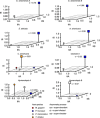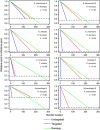Corrigendum to Streicker et al. (2013) Differential sources of host species heterogeneity influence the transmission and control of multi-host parasites
- PMID: 26346689
- PMCID: PMC6886588
- DOI: 10.1111/ele.12477
Corrigendum to Streicker et al. (2013) Differential sources of host species heterogeneity influence the transmission and control of multi-host parasites
Abstract
In a recent article, we described a conceptual and analytical model to identify the key host species for parasite transmission in multi-host communities and used data from 11 gastro-intestinal parasites infecting up to five small mammal host species as an illustrative example of how the framework could be applied. A limitation of these empirical data was uncertainty in the identification of parasite species using egg/oocyst morphology, which could overestimate parasite sharing between host species. Here, we show that the key results of the original analysis, namely that (1) parasites naturally infect multiple host species, but typically rely on a small subset of infected host species for long-term maintenance, (2) that different mechanisms underlie how particular host species dominate transmission and (3) that these different mechanisms influence the predicted efficiency of disease control measures, are robust to analysis of a smaller subset of host-parasite combinations that we have greatest confidence in identifying. We further comment briefly on the need for accurate parasite identification, ideally using molecular techniques to quantify cross-species transmission and differentiate covert host specificity from true host generalism.
© 2015 John Wiley & Sons Ltd/CNRS.
Figures


Erratum for
-
Differential sources of host species heterogeneity influence the transmission and control of multihost parasites.Ecol Lett. 2013 Aug;16(8):975-84. doi: 10.1111/ele.12122. Epub 2013 May 28. Ecol Lett. 2013. PMID: 23714379 Free PMC article.
References
Publication types
LinkOut - more resources
Full Text Sources
Other Literature Sources

